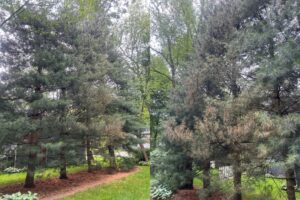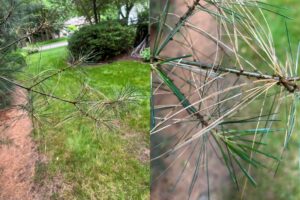Early June, we received a white pine sample at the Purdue University Plant and Pest Diagnostic Lab that showed early season needle loss lower in the tree canopy (Figure 1, 2). The majority of conifers hold onto their needles for multiple years, so loss of needles, even in the fall, can come as a shock to homeowners. In this particular case, we found multiple fungi that could be contributing to needle blight or needlecast.
- Figure 1: Eastern white pine trees with early season needle loss.
- Figure 2: Closeup images of white pine with needlecast. Multiple fungi were present: Lophodermium, Lecanosticta, and, Septorioides. Note, primarily the older needles have been affected. New needles appear green and healthy.
The first two fungi were determined to be relatively common pathogens for Indiana: Lophodermium and Lecanosticta (brown spot). Symptoms appeared relatively typical for these pathogens where the needles turned brown over-time. However, there were other needles in the canopy and on the sample that had a lighter coloration. We found small black fungal structures dotted along the length of these needles producing light colored cirrhi (also called spore horns) (Figure 3). After examining the fungal spores, isolating the fungus, and performing DNA testing, we determined this third fungus to be Septorioides strobi, the causal agent of Septoriorides needle blight of pines. This fungus has been determined to be a contributor to white pine needle damage/defoliation.
- Figure 3: Black fungal structures developing on dead needles with white sporulation exuding from the top.
White pine needle damage/defoliation (WPND) was first observed in the state of Maine in 2010 and was attributed to three needle blight diseases, including Lecanosticta, and has since been observed throughout the Northeast US. However, researchers eventually determined that a new fungus, Septorioides strobi, was also found consistently in blighted needles and could be contributing to WPND.
This is the first time we have found this fungus in the state of Indiana, though it has been present for longer than a single season. We do not know how it will react to our climate nor if it will cause significant damage to affected trees. Like other needle blight pathogens, Septorioides has been observed to sporulate around the same time during humid, wet weather, but symptoms may not develop until the following year. White pines are the primary host for this needle cast disease, but it can also develop on 2, 3, and 5 needle pines. While we see white pine decline is a major problem, Septorioides will not likely be the final nail in the coffin for white pines in Indiana, though it certainly will not help us keep them healthy.
Additional Resources
Septorioides Needle Blight
https://ag.umass.edu/landscape/fact-sheets/septorioides-needle-blight
Needlecast Diseases: Not Just a Spruce Problem
https://purduelandscapereport.org//article/needlecast-diseases-not-just-a-spruce-problem/
Red Band (Dothistroma) Needle Blight
https://purduelandscapereport.org//article/red-band-dothistroma-needle-blight/
Even Evergreen Needles Don’t Last Forever
https://purduelandscapereport.org//article/even-evergreen-needles-dont-last-forever/
Declining Pines of the White Variety
https://purduelandscapereport.org//article/declining-pines-of-the-white-variety/


